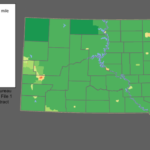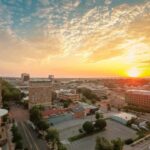
Embark on a comprehensive exploration of Rhode Island’s urban landscape, uncovering the unique narratives, cultural nuances, and economic dynamics that define each city in the top 10 by population.
Rhode Island’s cities are not merely statistical entities; they are vibrant hubs with distinct personalities, contributing to the rich tapestry of the state’s urban identity. This journey unfolds the stories behind the numbers, offering a detailed insight into the growth, culture, and economic vitality of Rhode Island’s largest cities.
Providence: The Capital Gem
- Population: Providence, the capital and the most populous city in Rhode Island, is home to a diverse community exceeding 180,000 residents;
- Cultural Hub: Beyond its numerical significance, Providence thrives as a cultural hub. The renowned WaterFire events illuminate the city’s rivers, blending art and community engagement. Providence’s cultural richness extends to iconic landmarks such as the Rhode Island School of Design (RISD) Museum and the Providence Performing Arts Center;
- Economic Influence: Providence’s economic landscape spans education, healthcare, and the arts. Renowned institutions like Brown University and the Rhode Island School of Design contribute not only to the city’s intellectual vibrancy but also play a pivotal role in shaping the Northeast Corridor’s economic landscape.
Providence’s neighborhoods, including Federal Hill, known for its Italian heritage, and College Hill, with its historic architecture, offer a diverse urban experience.
Warwick: Suburban Serenity with Urban Access
- Population: Warwick, the second-largest city with over 80,000 residents, strikes a balance between suburban tranquility and proximity to urban amenities;
- Residential Appeal: Warwick’s neighborhoods, including Cowesett and Buttonwoods, offer residents a suburban retreat characterized by parks, waterfronts, and a strong sense of community. Gaspee Days and Rocky Point State Park add cultural and recreational dimensions to the city’s appeal;
- Economic Connectivity: Warwick’s strategic location near T.F. Green Airport and major highways contribute to its economic connectivity. The city serves as a transportation hub and attracts businesses, fostering economic growth.
Cranston: Blending Residential Charm and Economic Vigor

Cranston, with over 80,000 residents, presents a harmonious blend of residential charm and economic vibrancy.
Historic Pawtuxet Village reflects Cranston’s colonial heritage, adding a touch of history to its urban fabric. The village, known for its historic homes and waterfront, contributes to Cranston’s distinctive character.
Garden City Center and Chapel View are economic hubs that contribute to Cranston’s vibrancy. These areas offer shopping, dining, and entertainment options, enhancing the city’s economic and recreational appeal.
Cranston’s neighborhoods, such as Edgewood and Oaklawn, showcase a mix of architectural styles, community pride, and a commitment to preserving historical elements.
Pawtucket: A Historical Tapestry of Innovation
- Population: Pawtucket, with a population surpassing 70,000, unfolds a historical tapestry of innovation and creativity;
- Cultural Evolution: From Slater Mill, considered the birthplace of the Industrial Revolution, to the vibrant arts community in Pawtucket’s Riverfront District, the city embraces cultural evolution. The mixed-use development of Hope Artiste Village is a testament to Pawtucket’s commitment to fostering a creative and entrepreneurial environment;
- Artistic Expression: Pawtucket’s commitment to artistic expression is evident in events like the Pawtucket Arts Festival, showcasing the city’s creative spirit. Local galleries, theaters, and public art installations contribute to the city’s vibrant cultural scene.
Explore the Rhode Island population in 2024 in this detailed review
East Providence: Waterfront Living and Community Spirit

East Providence, with over 47,000 residents, embraces waterfront living along the Seekonk River.
- Community Engagement: Bold Point Park hosts community events, fostering a sense of community engagement and providing residents with scenic waterfront spaces. The city actively promotes events like the East Providence Heritage Days, celebrating the city’s history and cultural diversity;
- Residential Diversity: From historic homes in Rumford to modern developments, East Providence offers a diverse residential landscape. The neighborhoods, such as Riverside and Watchemoket Cove, showcase a mix of architectural styles and waterfront living.
Woonsocket: Industrial Heritage and Community Resilience
- Population: Woonsocket, with a population exceeding 41,000, stands as a testament to industrial heritage and community resilience;
- Cultural Preservation: The Museum of Work and Culture preserves Woonsocket’s industrial past, contributing to the city’s cultural identity. The city actively engages in historical preservation, and events like the Autumnfest celebrate the community’s resilience and cultural heritage;
- Community Support: Woonsocket’s community initiatives, including festivals, local markets, and neighborhood events, showcase resilience and support for local businesses. The city’s downtown area has undergone revitalization, creating a vibrant hub for residents.
Coventry: Embracing Rural Tranquility
Coventry, with over 35,000 residents, embraces rural tranquility while being in close proximity to urban centers.
Green spaces like the Coventry Greenway and the Anthony P. Travisono Intrepid Fallen Heroes Park contribute to Coventry’s natural beauty. Residents enjoy outdoor activities, and the city actively promotes events like the Coventry Farmers’ Market.
The city’s neighborhoods, such as Washington Village and Tiogue Lake, reflect a harmonious blend of rural and suburban living. Coventry maintains its agricultural heritage while fostering a sense of community through local events and initiatives.
North Providence: Urban Living with a Residential Flair
- Population: North Providence, with over 32,000 residents, offers urban living with a residential flair;
- Educational Presence: Providence College’s influence contributes to the city’s educational atmosphere, attracting students and fostering a dynamic community. Residents have access to cultural and educational events, and the city actively promotes initiatives like the North Providence Heritage Hall of Fame;
- Neighborhood Unity: The city’s neighborhoods, including Fruit Hill and Marieville, showcase unity through community events and local initiatives. North Providence emphasizes community engagement, supporting local businesses, and preserving the city’s historical and cultural elements.
Uncover the best places to travel in Rhode Island, check this video
Cumberland: From Countryside to Suburban Sophistication
- Population: Cumberland, with a population exceeding 34,000, transitions from countryside charm to suburban sophistication;
- Historic Landscape: Diamond Hill Historic District reflects Cumberland’s historic charm, preserving architectural heritage amid modern developments. The Cumberland Monastery and the Blackstone River Bikeway contribute to the city’s historical and recreational appeal;
- Economic Growth: Cumberland Plaza and local businesses contribute to the city’s economic growth, offering a blend of history and contemporary commerce. The city actively promotes events like the Cumberlandfest, creating a sense of community and fostering economic vitality.
Johnston: A Blend of Industry and Community
- Population: Johnston, with over 30,000 residents, blends industrial roots with a strong sense of community;
- Industrial Presence: Johnston’s industrial parks contribute to its economic landscape, showcasing the city’s role in manufacturing and commerce. The city actively supports local businesses, and initiatives like the Johnston Apple Festival celebrate the community’s unity and entrepreneurial spirit;
- Community Initiatives: Local events and community initiatives, such as the Johnston Farmers’ Market and youth sports programs, highlight the city’s commitment to community engagement. Johnston’s neighborhoods, including Thornton and Johnston Gardens, reflect a blend of residential charm and a supportive community environment.
Bristol: Maritime Heritage and Coastal Beauty

- Population: Bristol, with a population over 22,000, embodies maritime heritage and coastal beauty;
- Historical Celebrations: The Bristol Fourth of July Parade, one of the oldest in the nation, reflects the city’s patriotic spirit and historical significance. Residents and visitors alike participate in this annual event, contributing to Bristol’s sense of community;
- Coastal Living: Bristol’s waterfront neighborhoods, including Hopeworth and Bristol Highlands, offer residents a coastal living experience. The town actively promotes events like the Bristol Harbor Festival, showcasing maritime traditions and fostering a vibrant waterfront community.
Interesting Facts
- Providence: The Renaissance City. Providence earned the moniker “The Renaissance City” due to its revitalization efforts in the 1970s, transforming abandoned buildings into thriving cultural spaces;
- Warwick: Green Airport. T.F. Green Airport in Warwick is named after Theodore Francis Green, a former Rhode Island governor and U.S. senator;
- Cranston: The Birthplace of the Gas Mask. Cranston has a unique claim to fame – it is the birthplace of the gas mask. The invention by Garrett Augustus Morgan, a Cranston resident, played a vital role during World War I;
- Pawtucket: Birthplace of the Industrial Revolution. Slater Mill in Pawtucket is considered the birthplace of the Industrial Revolution in the United States, marking a shift from agrarian to industrial economies;
- East Providence: Red Clock Tower. East Providence is home to a notable landmark, the red clock tower at East Providence City Hall, serving as a recognizable symbol for locals;
- Woonsocket: Mill Villages. Woonsocket’s history is intertwined with mill villages. The city’s Main Street Historic District showcases well-preserved mill architecture;
- Coventry: The Washington Oak. Coventry is home to the Washington Oak, where George Washington is said to have taken shelter during a storm in 1781;
- North Providence: Childhood Home of H.P. Lovecraft. Horror fiction writer H.P. Lovecraft spent his childhood in North Providence, and his experiences in the city influenced his eerie storytelling;
- Cumberland: Monastery Bells. Cumberland is home to the Monastery of the Poor Clares, where the melodious sound of bells echoes through the Blackstone Valley;
- Johnston: Apple Orchards. Johnston is known for its apple orchards, contributing to the city’s agricultural heritage. The Johnston Apple Festival celebrates this tradition;
- Bristol: Oldest Fourth of July Celebration. Bristol hosts the oldest continuous Fourth of July celebration in the United States, dating back to 1785.
Conclusion
Rhode Island’s cities by population create a diverse tapestry, each contributing its unique narrative to the state’s urban identity. From the historical significance of
Providence to the artistic flair of Pawtucket, these cities showcase Rhode Island’s resilience, creativity, and commitment to a vibrant future. As the state continues to evolve, its cities stand as dynamic hubs, inviting residents and visitors to explore the rich fabric of Rhode Island’s urban landscape.
Last modified: February 29, 2024

